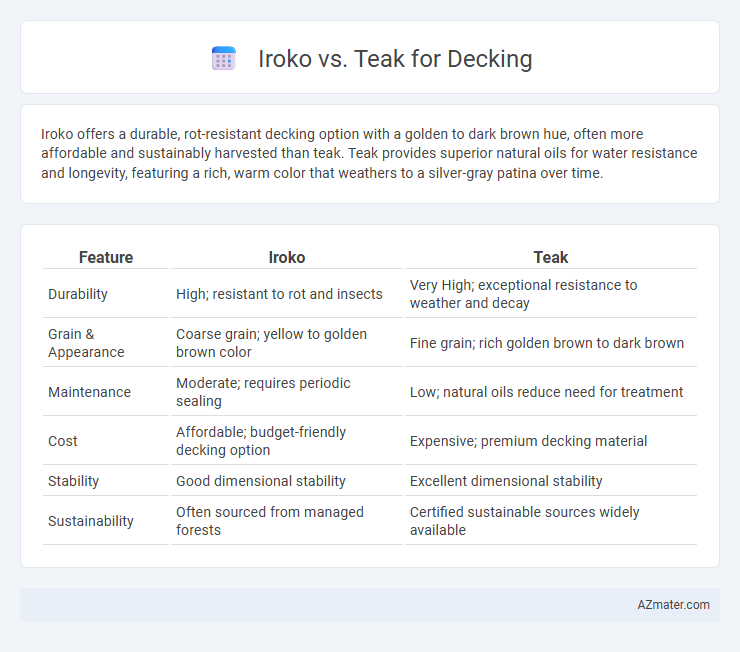Iroko offers a durable, rot-resistant decking option with a golden to dark brown hue, often more affordable and sustainably harvested than teak. Teak provides superior natural oils for water resistance and longevity, featuring a rich, warm color that weathers to a silver-gray patina over time.
Table of Comparison
| Feature | Iroko | Teak |
|---|---|---|
| Durability | High; resistant to rot and insects | Very High; exceptional resistance to weather and decay |
| Grain & Appearance | Coarse grain; yellow to golden brown color | Fine grain; rich golden brown to dark brown |
| Maintenance | Moderate; requires periodic sealing | Low; natural oils reduce need for treatment |
| Cost | Affordable; budget-friendly decking option | Expensive; premium decking material |
| Stability | Good dimensional stability | Excellent dimensional stability |
| Sustainability | Often sourced from managed forests | Certified sustainable sources widely available |
Introduction to Iroko and Teak Decking
Iroko and teak are premium hardwoods commonly used in decking for their durability and natural resistance to rot and insects. Iroko features a golden to medium brown color with a coarse texture, providing a cost-effective alternative to teak while maintaining high stability and low maintenance. Teak is renowned for its rich golden-brown hue, high oil content, and exceptional weather resistance, making it a top choice for luxurious, long-lasting outdoor decks.
Botanical Overview: Iroko vs Teak
Iroko (Milicia excelsa) is a hardwood native to West Africa, valued for its durability and resistance to decay, making it ideal for outdoor decking. Teak (Tectona grandis), originating from South and Southeast Asia, is renowned for its high oil content and natural weather resistance, ensuring longevity and minimal maintenance. Botanical differences between Iroko and Teak influence their grain patterns, density, and natural protective oils, which affect decking performance under various climatic conditions.
Appearance and Aesthetic Differences
Iroko decking features a golden to medium brown hue that darkens with age, offering a warm, natural appearance with visible grain patterns and occasional interlocking grains that add visual texture. Teak boasts a rich honey-golden color that weathers to a silver-gray patina if left untreated, admired for its smooth, straight grain and fine texture that provide an elegant, refined aesthetic. The contrast in color evolution and grain structure between Iroko's more varied patterns and Teak's uniform sleekness makes each wood distinct in enhancing outdoor deck designs.
Durability and Lifespan Comparison
Iroko wood offers exceptional durability with high resistance to decay and insect attacks, making it suitable for decking in various climates, often lasting between 25 to 30 years with proper maintenance. Teak stands out for its natural oils and dense grain, providing superior weather resistance and an average lifespan of 40 to 50 years, making it one of the most durable decking materials available. While teak typically outperforms iroko in longevity and requires less upkeep, iroko presents a more cost-effective option with respectable durability for long-term outdoor use.
Weather Resistance and Performance
Iroko wood excels in weather resistance due to its natural oils, making it highly resistant to moisture, decay, and insect attacks, which ensures durability in outdoor decking applications. Teak is renowned for its exceptional performance in harsh weather conditions, offering outstanding resistance to water, rot, and UV damage, thanks to its dense grain and natural oils. Both Iroko and Teak provide superior longevity and minimal maintenance, but Teak typically commands a higher price point for its premium weather resilience and aesthetic appeal.
Maintenance Requirements for Each Wood
Iroko decking requires minimal maintenance due to its natural resistance to rot, decay, and insect attacks, needing only occasional cleaning and oiling to maintain its color and durability. Teak demands more frequent upkeep, including regular cleaning and annual application of teak oil to preserve its rich golden hue and prevent surface drying or cracking. Both woods benefit from proper sealing, but Iroko's inherent resilience makes it a more low-maintenance option compared to teak's higher care requirements.
Environmental Impact and Sustainability
Iroko and Teak both offer durable options for decking, but Iroko is often considered more environmentally sustainable due to its faster growth rate and greater availability from managed plantations. Teak's slower growth and high demand have led to overharvesting concerns, impacting natural forests and biodiversity. Certifications like FSC (Forest Stewardship Council) help ensure both woods come from responsibly managed sources, minimizing environmental impact.
Cost and Availability Analysis
Iroko decking offers a more cost-effective alternative to teak, with prices typically 30-50% lower while maintaining similar durability and resistance to rot and insects. Iroko is widely available, sourced mainly from West Africa, making it easier to procure year-round, whereas teak, primarily harvested from Southeast Asia, faces supply constraints and higher demand driving its premium price. The cost-benefit balance often favors iroko for budget-conscious projects without compromising on longevity and performance in outdoor decking.
Suitability for Outdoor Decking Projects
Iroko wood offers excellent durability and natural resistance to rot and insect attacks, making it highly suitable for outdoor decking projects in various climates. Teak is prized for its exceptional water resistance and high oil content, which provide long-lasting protection and minimal maintenance for exposed decking. Both hardwoods are dense and stable, but iroko tends to be more affordable, while teak delivers superior longevity and a rich golden color that weathers gracefully over time.
Which is Better for Decking: Iroko or Teak?
Iroko and teak are both durable hardwoods commonly used for decking, but teak is often preferred for its superior natural oils that provide exceptional resistance to water, decay, and insects, ensuring long-lasting performance with minimal maintenance. Iroko, while also resistant and more affordable, tends to be slightly less stable and may require additional treatment to maintain its appearance over time. For homeowners seeking premium durability, weather resistance, and aesthetic appeal, teak remains the better choice for decking applications.

Infographic: Iroko vs Teak for Decking
 azmater.com
azmater.com